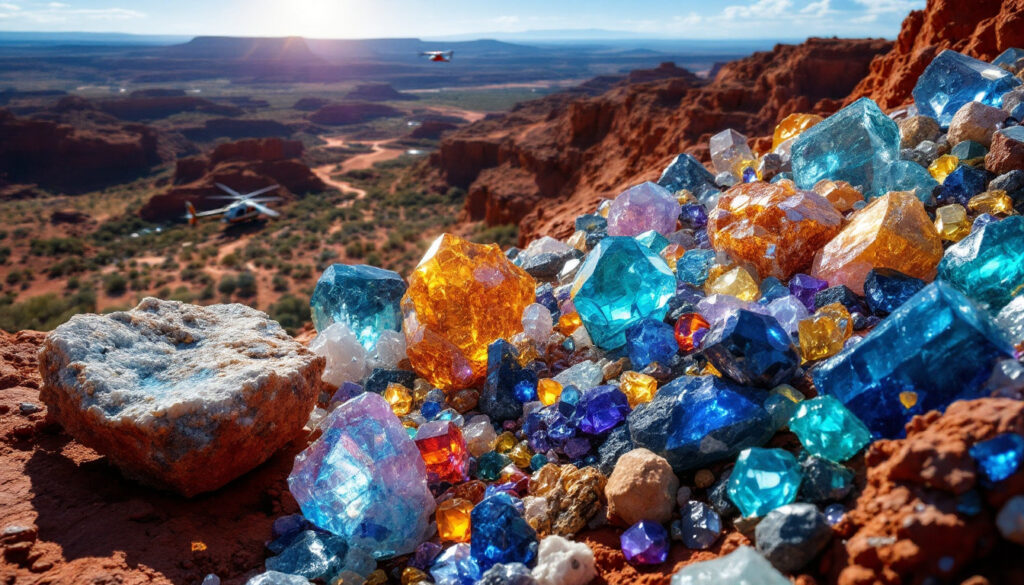NSW Critical Minerals Exploration Program: A $2.5 Million Investment
The NSW Critical Minerals Exploration Program represents a strategic $2.5 million government initiative recently announced by NSW Minister for Natural Resources Courtney Houssos. Launched on April 4, 2025, this ambitious program aims to accelerate the discovery of critical mineral deposits throughout New South Wales by providing substantial financial assistance to exploration companies.
The initiative comes at a crucial time when global demand for critical minerals continues to surge, driven by renewable energy technologies, electronics manufacturing, and defense applications. NSW's geological potential makes it an ideal location for discovering deposits that could strengthen Australia's position in global supply chains.
What is the NSW Critical Minerals Exploration Program?
The program is designed as a co-funding model that incentivizes explorers to undertake high-risk, high-reward exploration activities across NSW. By sharing the financial burden of early-stage exploration, the government aims to stimulate private investment in areas that might otherwise remain unexplored due to cost constraints.
The initiative targets minerals classified as "critical" due to their economic importance and supply risk factors. These include high-purity alumina, rare earth elements, lithium, cobalt, manganese, tungsten, and vanadium—materials essential for both civilian and military applications.
How the Funding Structure Works
The program's architecture features a strategic division of resources across four key exploration methodologies, ensuring comprehensive coverage of different exploration techniques.
Four Key Funding Streams
-
Exploration Drilling (>250m): Up to $250,000 available for deep drilling operations targeting subsurface deposits. These deeper drill programs are particularly important for investigating complex geological structures that may host significant critical mineral systems.
-
Exploration Drilling (<250m): Up to $150,000 available for shallower drilling campaigns. These programs are typically more cost-effective and allow companies to test multiple targets efficiently.
-
Geophysics: Up to $70,000 available for advanced geophysical surveys. Modern geophysical techniques like electromagnetic surveys cost approximately $120/km² and are crucial for identifying potential mineral-bearing structures without disturbing the surface.
-
Geochemistry: Up to $50,000 available for systematic soil, rock, and water sampling programs. Geochemical analyses provide essential data on mineral compositions and distributions, costing between $30-75 per sample for comprehensive multi-element assays.
Funding Requirements
Applicants must contribute 50% of the total project funding, creating a genuine partnership between government and industry. This requirement ensures companies have significant "skin in the game" while effectively doubling the exploration investment across NSW.
The funds are distributed on a reimbursement basis following approval and completion of work programs, ensuring accountability and proper utilization of government resources. The program prioritizes regions with underdeveloped mineral surveys, encouraging explorers to venture into frontier areas with high discovery potential.
Why Critical Minerals Matter for Australia
Critical minerals form the foundation of modern economies, powering everything from smartphones to fighter jets. Australia's strategic position as a politically stable supplier in an increasingly volatile global market presents both economic and geopolitical opportunities.
Australia's Critical Minerals Strategy
Australia has identified 31 critical minerals essential to technological advancement, economic development, and national security priorities. This comprehensive list guides policy development and investment decisions at federal and state levels.
What makes these minerals "critical" is not just their economic value but also their supply risk. Many face concentration risks in production, processing, or both—with China's rare earth export controls and supply chain challenges creating significant vulnerabilities. For instance, China controls between 80-95% of processing capacity for 8 of the 12 NATO-designated defense-critical materials.
The Australian government has recognized that developing domestic critical minerals resources represents a strategic imperative, not merely an economic opportunity. NSW's $2.5 million exploration program aligns perfectly with this national priority and complements Australia's transformative critical minerals investment initiatives at the federal level.
Defence Applications of Critical Minerals
The strategic importance of critical minerals extends well beyond civilian applications, with defense technologies increasingly dependent on these specialized materials.
NATO's Defence-Critical Raw Materials
NATO published a list of 12 defence-critical raw materials in December 2024, highlighting materials considered essential for military capabilities. These include:
- Aluminum (high-purity grades for aerospace)
- Beryllium (used in missile guidance systems)
- Cobalt (jet engine superalloys)
- Gallium (radar and satellite communications)
- Germanium (infrared optics and night vision)
- Graphite (missile components and batteries)
- Lithium (portable power systems)
- Manganese (hardening steel for armor)
- Platinum (catalytic systems)
- Rare earth elements (precision-guided munitions)
- Titanium (aircraft structures)
- Tungsten (penetrator rods for anti-tank munitions)
Supply Chain Vulnerabilities
The concentration of processing capacity in a single geopolitical sphere—primarily China—creates significant supply vulnerabilities for Western nations. While Australia possesses world-class resources of many critical minerals, the processing capacity to transform these raw materials into usable industrial inputs often resides offshore.
This vulnerability is particularly acute for materials like rare earth elements, where China controls approximately 85% of global processing capacity despite accounting for only about 60% of raw material production. Similar bottlenecks exist for tungsten, graphite, and several other defense-critical materials.
Australia's resource potential represents a strategic opportunity to diversify global supply chains, but this requires significant investment in both exploration and downstream processing capabilities. The NSW exploration program represents an important first step in this longer strategic journey, particularly given mining's crucial role in the clean energy transition.
Industry Response to the NSW Initiative
The announcement of the $2.5 million Critical Minerals Exploration Program has generated substantial interest within Australia's mining and exploration sector, with industry bodies offering strong endorsement.
AMEC's Support for the Program
The Association of Mining and Exploration Companies (AMEC), which represents over 400 mining and exploration companies across Australia and New Zealand, has expressed enthusiastic support for NSW's initiative.
"It shows a high-level of understanding and listening to the concerns of industry from Minister Houssos." – Warren Pearce, AMEC CEO
This endorsement follows AMEC's rigorous 14-day technical review process, indicating the program's alignment with industry needs and best practices.
Benefits Highlighted by AMEC
The industry association highlighted several key advantages of the NSW program:
- Reinforces government commitment to exploration as a national priority
- Demonstrates proactive approach to addressing supply chain vulnerabilities
- Positions NSW as a potential major player in critical minerals discovery and development
- Recognizes that early-stage exploration represents the highest-risk phase requiring public-private partnership
Industry surveys indicate that approximately 78% of exploration companies consider co-funding programs essential for undertaking greenfield exploration projects, particularly in commodities where market pricing remains volatile or uncertain.
Australian Companies Exploring Critical Minerals
The critical minerals sector in Australia features a diverse ecosystem of exploration companies, from major miners diversifying their portfolios to specialized junior explorers focused exclusively on specific critical minerals.
Junior Explorers in the Critical Minerals Space
Several ASX-listed junior exploration companies are actively pursuing critical minerals opportunities in NSW, including:
-
ABx (ASX:ABX): Focused on high-purity alumina and rare earth elements in central NSW, with a flagship project near Orange showing promising initial results.
-
American Rare Earths (ASX:ARR): Developing the Dubbo Project containing an estimated 560Mt resource at 0.45% total rare earth oxides, one of the largest potential rare earths sources in Australia.
-
Astute Metals (ASX:ASE): Targeting nickel-cobalt systems in the Lachlan Fold Belt using advanced electromagnetic survey techniques.
-
Black Canyon (ASX:BCA): Exploring for high-grade manganese deposits suitable for battery applications in western NSW.
-
Burley Minerals (ASX:BUR): Developing lithium-cesium-tantalum pegmatite targets near Broken Hill.
-
Cazaly Resources (ASX:CAZ): Applying innovative exploration methods including machine learning algorithms to identify cobalt and nickel targets.
-
Critica (ASX:CRI): Specializing in rare earth element discovery using proprietary geochemical techniques.
-
Firebird (ASX:FRB): Advancing cobalt-nickel laterite targets in the Lachlan Fold Belt, with initial drilling results showing grades comparable to operating mines.
-
Iltani Resources (ASX:ILT): Exploring for strategic metals including antimony and tungsten.
-
Impact Minerals (ASX:IPT): Implementing a successful geochem program after securing $210,000 in previous government funding.
-
Kingsrose (ASX:KRM): Focusing on critical battery metals exploration in the state's western regions.
-
QEM (ASX:QEM): Developing vanadium resources targeting both steel and emerging battery applications.
-
Solis Minerals (ASX:SLM): Exploring for copper and associated critical minerals.
-
Victory Metals (ASX:VTM): Targeting titanium and vanadium deposits with potential defense applications.
These companies range in market capitalization from approximately $15 million (Iltani) to $280 million (American Rare Earths), demonstrating the sector's diversity and growth potential.
How to Maximize Exploration Success in NSW
Successful mineral exploration requires a strategic approach combining technical excellence, financial discipline, and effective stakeholder management. Companies seeking to leverage the NSW Critical Minerals Exploration Program can maximize their chances of success through careful planning.
Strategic Approaches for Explorers
Leveraging Government Support
-
Optimize funding applications: Structure exploration programs to maximize the impact of government co-funding. Projects should be designed to answer critical geological questions that could significantly improve the understanding of mineral systems.
-
Combine government funds with private investment: Use the government co-funding as leverage when approaching private investors, demonstrating reduced risk and government endorsement.
-
Focus on priority minerals: Align exploration targets with minerals specifically mentioned in national strategic documents, increasing chances of both funding success and eventual project development.
-
Prepare JORC-compliant reporting: All drill results must comply with understanding the JORC Code for robust exploration reporting standards to satisfy funding requirements and build credibility with investors.
Technical Considerations
-
Utilize multiple exploration techniques: The most successful exploration programs typically employ a multi-disciplinary approach. Current best practices include:
- Airborne electromagnetic surveys (approximately $120/km²)
- Ground-based induced polarization surveys ($400/day)
- Systematic soil sampling on 100-200m grids
- Targeted drilling of anomalies identified through geophysics and geochemistry
-
Budget effectively: Current industry benchmarks for drilling costs in NSW average $280/meter for reverse circulation drilling and $550/meter for diamond drilling. Explorers should allow for 15-20% contingency in budgets to account for weather delays and technical challenges.
-
Develop strategic partnerships: Collaboration between companies with complementary expertise can enhance exploration success. Technical partnerships with research institutions or equipment manufacturers can provide access to cutting-edge technologies.
-
Navigate land access effectively: Early engagement with landholders and Indigenous communities is essential. Companies should familiarize themselves with NSW's Indigenous land access protocols to ensure respectful and legally compliant operations.
FAQs About NSW Critical Minerals Exploration
What are the key critical minerals being targeted in NSW?
Critical minerals being targeted include high-purity alumina, antimony, gallium, graphite, indium, lithium, manganese, nickel, rare earth elements, tungsten, and vanadium. These minerals have been identified as strategically important due to their applications in advanced technologies and potential supply constraints.
How does the co-funding model work?
Explorers must contribute 50% of the total project funding, with the government providing matching funds up to the specified limits for each exploration activity. Funds are distributed on a reimbursement basis following completion of approved work programs and submission of required technical reports.
Why is the NSW Government investing in critical minerals exploration?
The investment aims to secure Australia's position in global critical minerals supply chains, support national security interests, create economic opportunities within the state, and address the potential supply chain vulnerabilities associated with heavy concentration of processing capacity in China.
How does this program compare to other state initiatives?
The NSW program represents a targeted approach to critical minerals exploration that complements federal and other state initiatives. Queensland, for example, offers 25% royalty rebates for critical minerals projects, while the NSW program focuses more directly on early-stage exploration risk mitigation.
What technical reporting is required?
All drilling results must conform to JORC 2012 compliance standards. Detailed technical reports including assays, geological logs, and interpretations must be submitted to receive reimbursement under the program. For newcomers to the industry, a beginner's guide to understanding mining drilling results can help interpret these technical requirements.
Can international companies apply?
Yes, international companies can apply for funding provided they have a NSW-registered subsidiary and meet all other eligibility requirements under the Mining Act 1992. This openness to international participation helps attract global expertise and capital to the NSW exploration sector.
Want to Stay Ahead of the Next Major Mineral Discovery?
Discovery Alert's proprietary Discovery IQ model provides real-time notifications of significant ASX mineral discoveries, transforming complex geological data into actionable investment insights. Explore historic returns from major discoveries at Discovery Alert's discoveries page and position yourself to capitalise on market-moving announcements.




